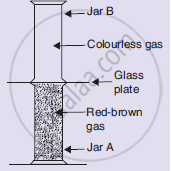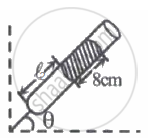Advertisements
Advertisements
प्रश्न
Look at the diagram on the right side. Jar A contains a red-brown gas whereas jar B contains a colourless gas. The two gas jars are separated by a galas plate placed between them
- What will happen when the glass plate between the two jars is pulled away?
- What name is given to the phenomenon which takes place?
- Name the brown gas which could be in jar A.
- Which is the colourless gas most likely to be present in jar B?
- Name one coloured solid and one colourless liquid which can show the same phenomenon.

उत्तर
- When the glass plate between the two jars is pulled away then the red brown gas will diffuse from jar A into colourless jar B and vice versa, due to which the red brown colour will spread into jar B.
- The phenomenon occurring here is diffusion.
- Bromine vapour.
- Air.
- Potassium permanganate (coloured solid) and water (colourless liquid) also show the same phenomenon.
APPEARS IN
संबंधित प्रश्न
Name two gases which are supplied in compressed form in homes and hospitals.
Write the full forms of the following
- LPG
- CNG
If the fish is being fried in a neighbouring home, we can smell it sitting in our own home. Name the process which brings this smell to us.
Give one example of diffusion of gases in a liquid.
Why does a gas fill a vessel completely?
Why do gases not have fixed shape?
Comment upon the following:-
filling a gas container
Comment upon the following:-
density
 |
|
| Fig. I | Fig. II |
In figure-I, an air column of length ℓ1 is entrapped by a column of Hg of length 8 cm. In figure-II length of same air column at the same temperature is ℓ2. The `ℓ_1/ℓ_2` is:
(1 atm = 76 cm of Hg)
2 litre He gas at 2 atm and 300 K is inserted into a 4 litre rigid container containing N2 at 600 K and 4 atm. Finally mixture is maintained at 600 K temperature. The final pressure of gaseous mixture would be ______ torr.

